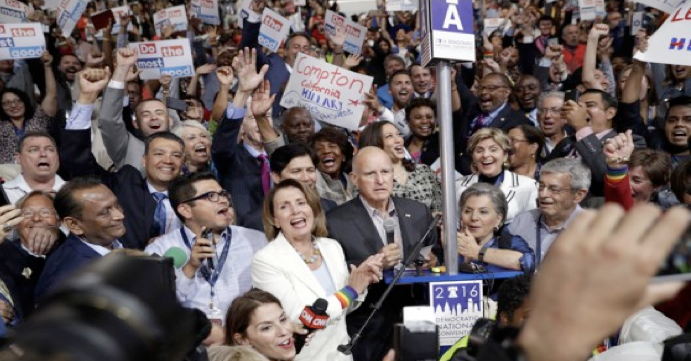CommentsNEW GEOGRAPHY-- Across the country, white voters placed Donald Trump in office by a margin of 21 points over Clinton. Their backing helped the GOP gain control of a vast swath of local offices nationwide. But in California, racial politics are pushing our general politics the other direction, way to the left.
Some of this reflects California’s fast track toward a “minority-majority” state. Along with a few other states — Hawaii, Texas and New Mexico — California is there now, with minorities accounting for 62 percent of the population, compared to 43 percent in 1990. The shift in the electorate has been slower but still powerful. In 1994, registered Democrats held a 12 percentage-point margin over Republicans. By 2016, the margin had widened to 19 points.
The racial shift does much to explain why Trump lost some largely affluent suburban areas like Orange County, where 53 percent the population is Latino or Asian, up from 45 percent in 2000. Perhaps most emblematic of potential GOP problems was Trump’s — and the GOP’s — loss in Irvine, a prosperous Orange County municipality that is roughly 40 percent Asian.
California’s unique racial politics
Ideology plays a critical role in California’s emerging politics of race. Hispanic and Asian voters outside California — for example, in Texas — have tended to vote less heavily for Democrats. In 2014, Republican Gov. Greg Abbott won 44 percent of Texas Latinos. Florida’s Gov. Rick Scott garnered 38 percent of the Latino vote in his successful re-election campaign. In contrast, that same year, Neel Kashkari, Jerry Brown’s Republican opponent, won only 27 percent of the Latino vote in California. Only 17 percent of California Asians voted for Trump, nearly 40 percent lower than the national rate (27 percent).
These differences, ironically, have become more evident as California has become relatively less attractive to immigrants. Since the 1980s and 1990s, as California’s economy has become increasingly deindustrialized, the immigration “flood” has slowed, particularly among Hispanics. By the 2010s, other cities — notably Dallas-Fort Worth and Houston — were emerging as bigger magnets for newcomers.
These areas, with lower costs, generally work better for less-skilled immigrants. Latinos in Texas, particularly, do better than their counterparts in California — as measured by homeownership, marriage rates and incomes — and also tend to vote more conservatively.
Part of this reflects different political attitudes among minority leaders in the two states. “We’re not going to do it with welfare, we’re not going to do it with income maintenance, we’re not going to do it remaining contentious and divided,” notes Democrat Henry Cisneros, San Antonio’s first Hispanic mayor and later U.S. secretary of housing and urban development. “We’re going to do it if we come around a single theme: jobs.”
In contrast, California’s racial politics focuses more on serving an increasingly “stranded population” of poor people with limited opportunities for advancement. Indeed, a stunning United Way study found that half of all Latinos, and some 40 percent of African Americans, have incomes below the cost of necessities (the “Real Cost Measure”). Among non-citizens, 60 percent of households have incomes below the Real Cost Measure, a figure that deteriorates to 80 percent among Latinos.
Building a sanctuary for poverty
Zealous boosters of “diversity,” California progressives also embrace policies — in fields like energy, housing and workplace regulation — that place strong barriers to upward mobility. They have undermined what’s left of the industrial economy, and also opposed the production of new single-family houses. Jason Furman, the chairman of President Obama’s Council of Economic Advisers, has shown that the single-family house, on average, contributes 2.5 times as much to the gross domestic product as a multi-family unit.
Instead, today’s new-style progressives — who are primarily concerned with wealth redistribution, racial redress and climate change — have done little to address the ramifications of an increasingly deindustrialized economy that has cut into blue-collar opportunities. Rather than pushing growth, they have placed their emphasis on ever-increasing subsidies for the poor, including those working in expanding low-wage service industries.
To break this pattern, we need a different set of policies, whether they come from moderate, pro-business Democrats or what is left of the California Republican Party. The primary need is to replace welfarism with a strong, pro-growth agenda. This, critically, would include the expansion of single-family housing, something the American Interest’s Walter Russell Mead suggests could spark a new economic expansion. Since 2000, more than 95 percent of the minority growth in the 52 largest metropolitan areas has been in suburban and exurban areas.
If President-elect Trump succeeds in promoting policies that unlock growth, in part, by sweeping away the worst anti-economic growth regulations, it could create a new wave of opportunity for minority Americans. It would be a tragedy of historic proportions if California, long the object of so many immigrants’ dreams, ends up choosing dependency over opportunity.
(Joel Kotkin is the R.C. Hobbs Presidential Fellow in Urban Futures at Chapman University in Orange and executive director of the Houston-based Center for Opportunity Urbanism (www.opportunityurbanism.org). Wendell Cox is principal of Demographia, a St. Louis-based public policy firm, and was appointed to three terms on the Los Angeles County Transportation Commission. This article was posted most recently at New Geography.)
-cw
Explore
Our mission is to promote and facilitate civic engagement and neighborhood empowerment, and to hold area government and its politicians accountable.

 CityWatch Los Angeles
Politics. Perspective. Participation.
CityWatch Los Angeles
Politics. Perspective. Participation.
02
Mon, Jun















